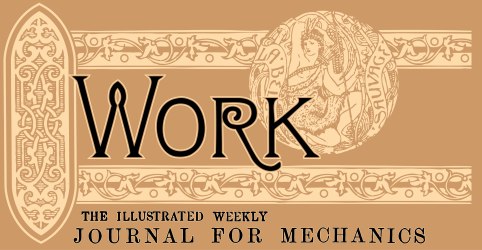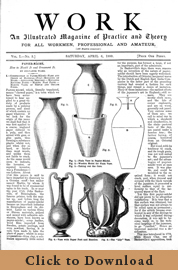Greetings Workateers! Ladies and Gentlemen, I'm pleased to announce that the Eiffel Tower is nearly finished, and looks to be ready for the opening on the 1st of May. The Stratford-On-Avon church is to be illuminated with electric light; and a street cleaning apparatus has been devised to supplant sweepers on the streets of London. It's April 6th, 1889. Issue No. 3 of Work has hit the stands.
Heady times such as these call for a radical reappraisal of working methods. I'm talking about Papier-Mâché.
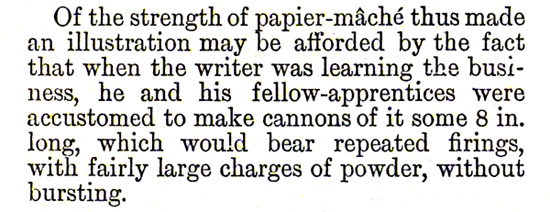
Clearly, this isn't the same Papier-Mâché of flimsy, grade-school dioramas and smocks covered in wheat paste. For instance, I've never heard of Papier-Mâché projects that could withstand turning as a secondary operation— until now.
Issue No. 3 also brings us the conclusion of the serialized article, "Artistic Furniture," wherein, the decorative elements are constructed and applied to the overmantel and cupboards. It covers the interesting technique of applying ornamental dentils made from printers'
reglets, as well as various aspects of successfully mounting panels, decorative and otherwise.
"A Simple Ceiling in Wood" turns out to be the sleeper hit of the issue for me. Hiram Price describes himself as a man who has personally seen to every aspect of the construction of his residence. He also abhors plaster. The article describes the methods by which Price prepared and installed a decorative treatment for exposed joists. The techniques are all straightforward, but appear to yield elegant results. He makes mention of the possibility of paint as a means of adding additional embellishment:

"The Campbell Apartment!" I was on the train when I read issue No. 3 for the first time. I don't often make a habit of blurting out in public to no one in particular but it couldn't be helped. I had seen a ceiling like Price's somewhere before.
If you're lucky enough to be passing through Grand Central Terminal in the mid afternoon, and you happen to conform to the dress code (no baseball caps, t-shirts, athletic shoes, etc.), by all means stop in at The Campbell Apartment. The decor is something to behold, but the
ceiling is, by far. my favorite part. Now, thanks to Price, it appears I have some insight into its construction. I'm going to wind up with a sore neck the next time I visit. In any case, I can't wait to read the subsequent installment of Price's treatise.
The sections on
crystoleum painting and the reproduction photographic negatives bear mentioning here. "Tips for Tyros" gives two methods for the reproduction of carvings and relief medallions; and supplement to "Our Guide to Good Things," which covers a variety of lathe accessories, there is a review of Price's "Universal" Lathe. It boasts the curious addition of a "vertical" slide which enables the user to "mill" a workpiece when it's clamped in the tool rest while a cutter is secured in the chuck. Not bad for £23 15s with all the bells and whistles.
–TIM
ARTICLES FOUND IN THIS ISSUE:
Papier-Mâché. • Artistic Furniture: Easily Made and Cheaply Produced (continued)
• Photographic Negatives: Their Reproduction and Multiplication
A Simple Ceiling In Wood • The Bunsen Battery (Part 3) • Crystoleum Painting
Tips For Tyros • Price's Universal Lathe • Our Guide To Good Things
Means, Modes, And Methods • Shop: A Corner For Those Who Want To Talk It
• Click to Download Vol.1 - No.3 •
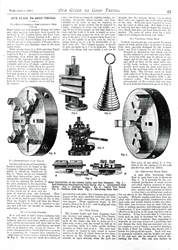
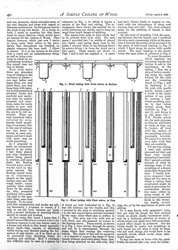
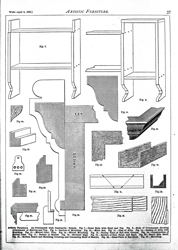
Disclaimer: Articles in Work: The Illustrated Weekly Journal for Mechanics describe materials and methods that would not be considered safe or advisable today. We are not responsible for the content of these magazines, and cannot take any responsibility for anyone attempting projects or procedures described therein.
The first issue of Work was published on March 23rd, 1889. The goal of this project is to release digital copies of the individual issues starting on the same date in 2012, effectively republishing the materials 123 years to the day from their original release.
The original printing was on thin, inexpensive paper. There are many cases of uneven inking and bleed-through from the page behind. Our copies of Work come from bound library volumes of these issues and are subject to unfavorable trimming, missing covers, etc. Please bear with us if a margin is clipped too close, or a few words are unreadable. To minimize harm to these fragile volumes, we've undertaken the task of scanning the books ourselves. We would like to thank James Vasile and Karl Fogel for their help in supplying us with a book scanner and generally enabling this project to get off the ground.
The original content is out of copyright, however, our scans and processing are not. You are welcome to download, print, and pretty much do what you want with the scan for your own personal purposes. Feel free to post a link or a copy on your blog or website. All we ask is a link back to the original project and this blog. We are not giving permission for commercial downloads or reprinting at this time.
 Joel's Blog
Joel's Blog Built-It Blog
Built-It Blog Video Roundup
Video Roundup Classes & Events
Classes & Events Work Magazine
Work Magazine















